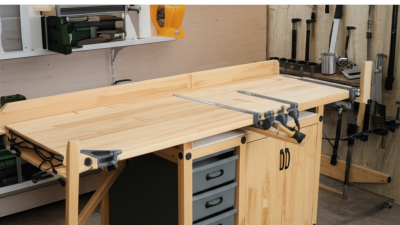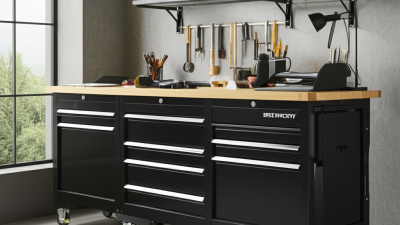The Ultimate Guide to Choosing the Perfect Shop Workbench for Your DIY Projects
When diving into the world of DIY projects, one of the most critical decisions you will face is selecting the right shop workbench. A well-designed workbench not only enhances your workspace but also improves your efficiency and creativity while tackling various tasks. With countless options available on the market, finding the perfect shop workbench tailored to your specific needs can be a daunting challenge.

In this ultimate guide, we aim to simplify this process by providing valuable insights into the different types of shop workbenches, their essential features, and considerations that will help you make an informed choice. From sturdy models designed for heavy-duty projects to versatile, space-saving designs ideal for limited areas, understanding the nuances of each option can dramatically influence the success of your DIY endeavors.
Whether you’re a seasoned craftsman or a beginner looking to embark on your creative journey, choosing the right shop workbench is a fundamental step that will set the stage for countless successful projects.
Understanding Your DIY Needs: Types of Shop Workbenches Explained
When embarking on DIY projects, understanding the types of shop workbenches is crucial to meet your specific needs. There are various categories of workbenches tailored for different tasks, including portable benches for mobility, heavy-duty benches designed for robust use, and multi-functional benches that offer versatility. Evaluating your space, the type of projects you'll undertake, and your level of expertise can guide you toward the perfect choice.
Furthermore, the incorporation of essential tools like bench vises cannot be overlooked. A quality bench vise acts as a reliable assistant, holding projects securely in place, allowing for both hands to be free for more intricate tasks. This is especially important in scenarios where precision is key, such as woodworking or crafting custom items. With the right workbench and accessories, you can elevate your DIY game, ensuring efficiency and enjoyment in every creative endeavor.
The Ultimate Guide to Choosing the Perfect Shop Workbench for Your DIY Projects
This chart demonstrates the popularity of different types of shop workbenches based on DIY project preferences. Woodworkbenches top the list, followed by metal options, while foldable models are the least popular among DIY enthusiasts.
Key Features to Consider When Selecting a Shop Workbench
When selecting the perfect shop workbench for your DIY projects, there are several key features to consider that can significantly enhance your workspace efficiency. First, the size of the workbench is crucial. It should offer ample surface area to accommodate your projects while still fitting comfortably in your shop space. Look for a bench that provides enough height for \
ergonomic working, allowing you to spend hours on your projects without strain. A sturdy design is also essential, as it ensures stability while you work, especially when using heavy tools or materials.
Another important feature is storage options. A workbench that includes built-in drawers, shelving, or pegboards can help you keep tools and materials organized and within easy reach. This reduces clutter and maximizes productivity, allowing you to focus on your projects instead of searching for misplaced items. Additionally, consider the material of the workbench surface; a durable, easy-to-clean surface, such as hardwood or composite materials, will stand up to wear and tear while providing a reliable workspace for various tasks.
Material Matters: Choosing the Right Construction for Durability
When selecting the ideal shop workbench for your DIY projects, the choice of material is crucial for ensuring longevity and strength. Different materials offer various benefits: solid wood, for instance, is known for its durability and can withstand heavy use. Its robust nature allows it to absorb shocks and resist scratches, making it an excellent choice for those who frequently engage in rigorous tasks. Plywood and MDF (medium-density fiberboard) offer cost-effective alternatives while still providing a decent working surface, although they may not be as resilient under heavy loads.
On the other hand, metal workbenches are gaining popularity due to their ability to handle substantial weight and resist chemical spills, which is particularly beneficial in workshops where diverse materials are used. Additionally, stainless steel options are fantastic for their corrosion resistance and easy cleaning. It's essential to consider how you will use the workbench, as well as the types of projects you intend to tackle. Ultimately, selecting the right material will not only enhance your workbench's performance but also extend its lifespan, ensuring reliable support for your creative endeavors.
Size and Space: How to Select the Ideal Dimensions for Your Workspace
When it comes to selecting the perfect shop workbench for your DIY projects, size and space are critical considerations. The first step is to evaluate the dimensions of your workspace. Measure the area where the workbench will be located, accounting for both floor space and vertical clearance. A workbench that is too large can overwhelm a small space and restrict movement, while one that is too small might not accommodate your tools and materials effectively. Aim for a balance that allows for easy access to your equipment while providing room to work comfortably.
Next, consider the ideal dimensions of the workbench itself. A height of 36 inches is generally recommended for standard tasks, but this may vary based on your personal height and comfort. The width and depth should also accommodate your typical projects; benches around 24 to 36 inches deep provide ample work area without consuming too much space. Additionally, if you plan to use power tools, ensure that the bench can support the necessary weight and size of these tools. Tailoring your workbench dimensions to fit both your workspace and your specific projects will enhance your efficiency and enjoyment in the workshop.
Accessories and Customization: Enhancing Your Workbench for Maximum Efficiency
When it comes to maximizing the functionality of your shop workbench, the right accessories and customization options can make all the difference. Start by evaluating your specific DIY projects and tools; this can guide your selection of essential accessories. For instance, tool organizers, built-in power strips, and sturdy clamps can streamline your workflow and keep everything within reach.
**Tips:** Consider magnetic tool strips to keep frequently used tools visible and easily accessible while maintaining a clutter-free workspace. Furthermore, incorporating a dedicated surface for cutting or sanding can protect your workbench from wear and tear, extending its lifespan.
Customizing your workbench to better fit your needs also enhances efficiency. Adding drawer organizers for smaller items or utilizing pegboards for vertical storage can free up valuable surface space. Additionally, investing in adjustable height legs allows you to create an ergonomic workspace, catering to your comfort during long hours of work.
**Tips:** Look into rolling carts or additional side tables that can be attached to your workbench for extra space when needed. This flexibility can be a game changer for both small and large projects. With the right accessories and thoughtful customization, your workbench can become an indispensable ally in your DIY endeavors.
The Ultimate Guide to Choosing the Perfect Shop Workbench for Your DIY Projects - Accessories and Customization: Enhancing Your Workbench for Maximum Efficiency
| Feature | Description | Benefits |
|---|---|---|
| Table Surface Material | Laminate, Solid Wood, Steel | Durability and ease of cleaning |
| Workbench Height | Standard height or adjustable | Ergonomic comfort during use |
| Storage Options | Shelves, Drawers, Pegboards | Organization of tools and materials |
| Customization Accessories | Lighting, Vises, Tool Holders | Increased efficiency and productivity |
| Mobility Options | Wheels, Folding Design | Flexibility in workspace arrangement |
| Weight Capacity | Weight limit specifications | Safety in handling heavy materials |
Related Posts
-

How to Choose the Perfect Rolling Workbench for Your Workshop Needs
-

What Makes the Best Rolling Workbench Essential for Every Workshop
-

Unleashing the Power of Chinese Manufacturing for the Best Metal Work Benches Worldwide
-

How to Choose the Best Tool Workbench for Your DIY Projects
-

The Evolution of Workspaces with the Best Rolling Workbench Solutions
-

Transform Your Workspace: The Ultimate Guide to Building the Perfect Workbench Table
Footer
Resource Center
Contact Us
1901 West Main Street
Washington, MO 63090
Main Directory: 1-800-227-4873
Email: sale@pangcofurniture.com
Affiliations


